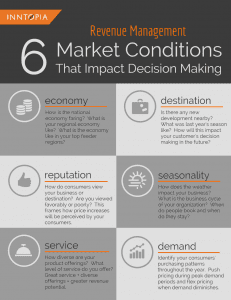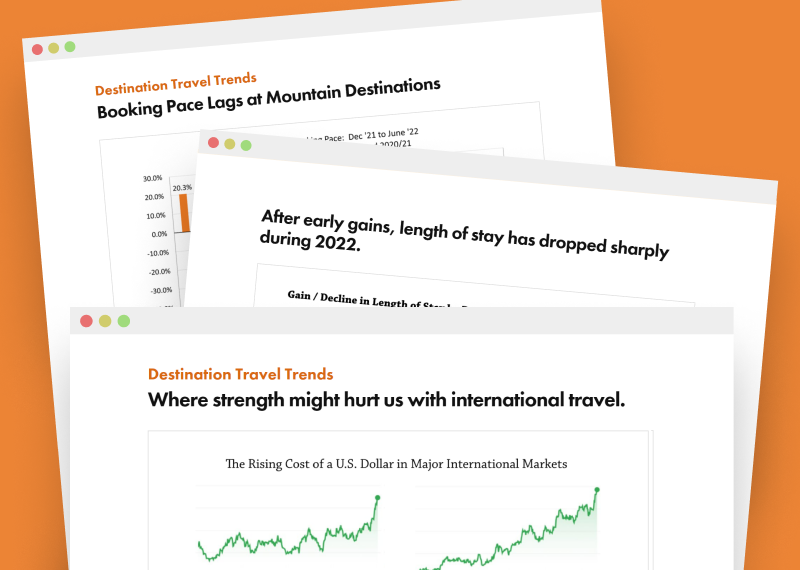

 Tyler Maynard
Tyler Maynard
I love “geeking out” over Revenue Management, can’t you tell? As a finance professional, I’ve trained myself to always look at the big picture when it comes to Revenue Management. This approach allows for staying a step ahead of the competition and industry trends, and for adjusting your strategy proactively when necessary.
I’d like to share six basic market conditions to consider when making decisions on how to manage your rates:
How are the wallets of your consumers faring these days? What’s the unemployment rate? Look at the national economy as well as your regional economy. What is the economy like in your top feeder regions? If your destination is largely dependent on foreign travel, but the economy is sluggish in those regions, that market segment will be impacted and requires change to overall marketing and revenue strategies.
2. Destination Conditions
Take a look at what is going on around you. Is there any new development happening that will draw crowds or impact product inventory? Think back to last year’s peak season; what it was like and how that might impact a guest’s decision making for this year. What was the overall impression of last year? Was it a big snow year or was it dry? Were there any hurricanes or natural disasters that impacted the region? Were there any special events last year that attracted guests to your destination?
3. Property / Resort Reputation
If you were a consumer, how would you view your property/resort? What about your destination as a whole? Step away from your role, and look at it through the eyes of the guest. Read reviews on TripAdvisor and travel blogs, and research your resort and destination name in an internet search. What do you find? What you find in a simple internet search is the same as what your potential customers will find.
If your reputation is favorable, there is potential opportunity to yield pricing up as there is a price expectation for a high-quality experience. This means the generation of more revenue off the same product organically, based on the public’s perception and willingness to part ways with money. This is one of the easiest ways to increase overall year-over-year (YOY) revenue performance and YOY profitability (assuming product costs remain consistent along with associated overhead).
But if your reputation is poor, this will be more difficult. What can your organization do to improve your reputation? With a poor reputation, it is always important to build a perceived value for consumers and establish a loyal business base before initiating any dramatic changes in rate increases.
4. Seasonality
How do weather trends or changes in seasons affect your business volume? Identify your “peak” business periods and manage your rates off of the demand cycle. Also, understand the business cycle of your organization based on key booking periods and key consumption periods. For example, if a premier ski destination’s key winter booking period is August through October, with consumption dates of January through March, how will that impact cash flow and resort operations for you?
5. Level of Service / Offerings
Good service equals greater revenue potential. Bad service…doesn’t require explanation. The higher the level of service you offer, the greater your ability is to increase your product pricing.
In addition, the more offerings a location has, the more appealing it will be to a greater number of people. Diversification of products is important for the long term financial success of larger organizations. The catch is that you still have to offer good service with all of the products you offer. Offering consumers more options with poor service will result in a poor reputation (see condition #3), and decreased revenue production given the investment it takes to bring new products on board.
6. Demand
Are you yielding based on demand? If not, it is wise to build a demand-calendar that focuses on key dates throughout the year. If you are a largely transient market, it makes sense to focus on peak/holiday times where you can push rates within that market, and then work with your sales and marketing team to fill remaining dates with events or group functions.
There is a lot to consider when managing your revenue opportunities. Stay on top of it by subscribing to industry publications and by simply reading the local, national, and international news. It’s time well spent, because no matter what, you will learn something. In the next post, we’ll take a look at forecasting and strategy.
Revenue Management, Part 1: The Basics
Have a question? Just ask.

Tyler Maynard
SVP of Business Development
Ski / Golf / Destination Research
Schedule a Call with Tyler→

Doug Kellogg
Director of Business Development
Hospitality / Attractions
Schedule a Call with Doug→
If you're a current Inntopia customer, contact support directly for the quickest response →
Request Demo
A member of our team will get back to you ASAP to schedule a convenient time.




